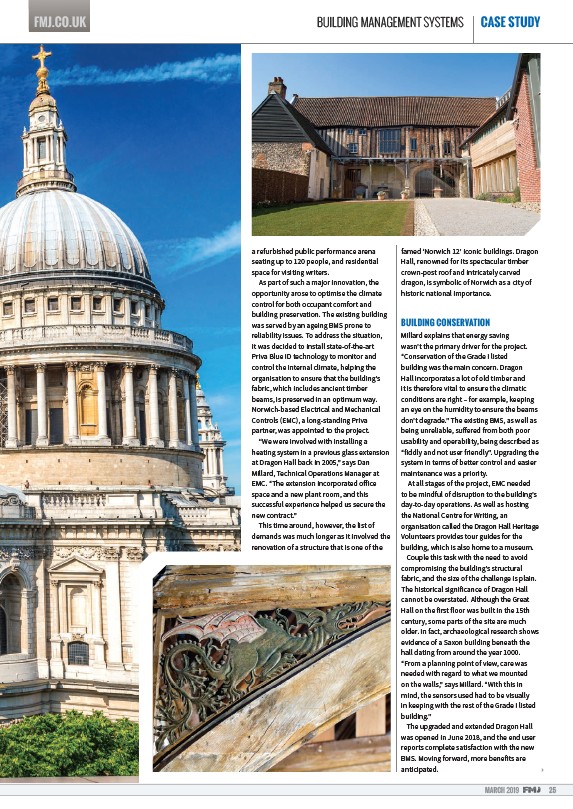
FMJ.CO.UK BUILDING MANAGEMENT SYSTEMS CASE STUDY
MARCH 2019 25
a refurbished public performance arena
seating up to 120 people, and residential
space for visiting writers.
As part of such a major innovation, the
opportunity arose to optimise the climate
control for both occupant comfort and
building preservation. The existing building
was served by an ageing BMS prone to
reliability issues. To address the situation,
it was decided to install stateoftheart
Priva Blue ID technology to monitor and
control the internal climate, helping the
organisation to ensure that the building’s
fabric, which includes ancient timber
beams, is preserved in an optimum way.
Norwichbased
Electrical and Mechanical
Controls (EMC), a longstanding
Priva
partner, was appointed to the project.
“We were involved with installing a
heating system in a previous glass extension
at Dragon Hall back in 2005,” says Dan
Millard, Technical Operations Manager at
EMC. “The extension incorporated oƒ ice
space and a new plant room, and this
successful experience helped us secure the
new contract.”
This time around, however, the list of
demands was much longer as it involved the
renovation of a structure that is one of the
famed ‘Norwich 12’ iconic buildings. Dragon
Hall, renowned for its spectacular timber
crownpost
roof and intricately carved
dragon, is symbolic of Norwich as a city of
historic national importance.
BUILDING CONSERVATION
Millard explains that energy saving
wasn’t the primary driver for the project.
“Conservation of the Grade I listed
building was the main concern. Dragon
Hall incorporates a lot of old timber and
it is therefore vital to ensure the climatic
conditions are right – for example, keeping
an eye on the humidity to ensure the beams
don’t degrade.” The existing BMS, as well as
being unreliable, suƒ ered from both poor
usability and operability, being described as
“fiddly and not user friendly”. Upgrading the
system in terms of better control and easier
maintenance was a priority.
At all stages of the project, EMC needed
to be mindful of disruption to the building’s
daytoday
operations. As well as hosting
the National Centre for Writing, an
organisation called the Dragon Hall Heritage
Volunteers provides tour guides for the
building, which is also home to a museum.
Couple this task with the need to avoid
compromising the building’s structural
fabric, and the size of the challenge is plain.
The historical significance of Dragon Hall
cannot be overstated. Although the Great
Hall on the first floor was built in the 15th
century, some parts of the site are much
older. In fact, archaeological research shows
evidence of a Saxon building beneath the
hall dating from around the year 1000.
“From a planning point of view, care was
needed with regard to what we mounted
on the walls,” says Millard. “With this in
mind, the sensors used had to be visually
in keeping with the rest of the Grade I listed
building.”
The upgraded and extended Dragon Hall
was opened in June 2018, and the end user
reports complete satisfaction with the new
BMS. Moving forward, more benefits are
anticipated.